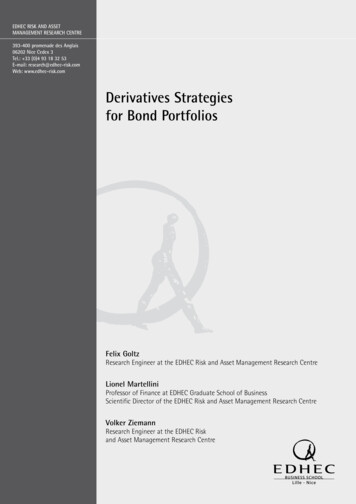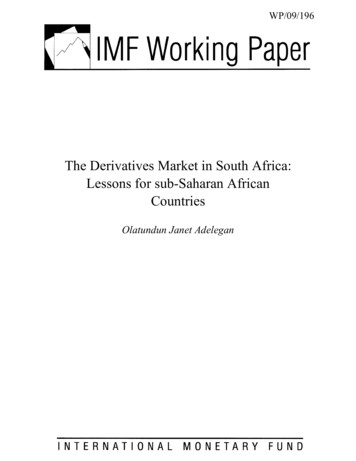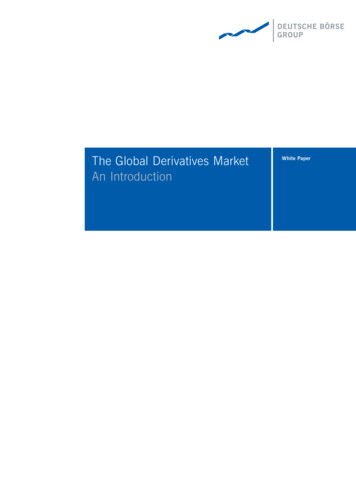
Transcription
EDHEC RISK AND ASSETMANAGEMENT RESEARCH CENTRE393-400 promenade des Anglais06202 Nice Cedex 3Tel.: 33 (0)4 93 18 32 53E-mail: research@edhec-risk.comWeb: www.edhec-risk.comDerivatives Strategiesfor Bond PortfoliosFelix GoltzResearch Engineer at the EDHEC Risk and Asset Management Research CentreLionel MartelliniProfessor of Finance at EDHEC Graduate School of BusinessScientific Director of the EDHEC Risk and Asset Management Research CentreVolker ZiemannResearch Engineer at the EDHEC Riskand Asset Management Research Centre
AbstractIn this paper, we examine how standard exchange-traded fixed-income derivatives (futures and options onfutures contracts) can be included in a sound risk and asset management process so as to improve risk andreturn performance characteristics of managed portfolios. Our results show that the non-linear character of thereturns on protective option strategies offers appealing risk reduction properties in the pure asset managementcontext. Consequently, such strategies should optimally receive a significant allocation, especially wheninvestors are concerned with minimising extreme risks. In an asset liability management context, we also showthat fixed-income derivatives in general, and recently launched long-term futures contracts in particular, offersignificant shortfall risk reduction benefits. These results have potentially significant implications in the contextof an increased focus on matching liability portfolios.This research is sponsored by EurexEDHEC is one of the top five business schools in France owing to the high quality of its academic staff (104permanent lecturers from France and abroad) and its privileged relationship with professionals that the schoolhas been developing since its establishment in 1906. EDHEC Business School has decided to draw on its extensiveknowledge of the professional environment and has therefore concentrated its research on themes that satisfythe needs of professionals.EDHEC pursues an active research policy in the field of finance. Its “Risk and Asset Management ResearchCentre” carries out numerous research programs in the areas of asset allocation and risk management in boththe traditional and alternative investment universes.Copyright 2007 EDHEC
IntroductionInterest in the use of fixed-income derivatives in asset management has perhaps never been so high, both from apure asset management perspective and from an asset-liability management perspective. On the one hand, froma pure asset management perspective, historically low levels of long-term yields, combined with the prospect ofincreases in short-term rates by central banks in Europe as well as in the United States, are a strong incentive toimplement strategies that aim to deliver downside protection by combining a long position in bond markets witha long position in put options. On the other hand, recent pension fund shortfalls have drawn attention to therisk management practices of institutional investors in general and defined benefit pension plans in particular,and have provided new incentives for institutional investors to use fixedincome derivatives in the managementof their liability risk."A perfect storm” of adverse market conditions around the turn of the millennium has devastated many corporatedefined benefit pension plans. Negative equity market returns have eroded plan assets at the same time asdeclining interest rates have increased the mark-to-market value of benefit obligations and contributions. Inextreme cases, this has left corporate pension plans with funding gaps as large as, or larger than, the marketcapitalization of the plan sponsor. For example, in 2003, the companies included in the S&P 500 and the FTSE100 index faced a cumulative deficit of 225 billion and 55 billion respectively, (as per surveys by Credit SuisseFirst Boston [2003] and Standard Life Investments [2003]), while the worldwide deficit reached an estimated1,500 to 2,000 billion USD (Watson Wyatt [2003]). That institutional investors in general and pension funds inparticular have been so dramatically affected by recent market downturns has emphasized the weakness of riskmanagement practices. In particular, it has been argued that the asset allocation strategies implemented inpractice, which were heavily skewed towards equities, in the absence of any protection with respect to theirdownside risk, were not consistent with sound liability risk management. In this context, new approaches,referred to as liability-driven investment solutions, have rapidly elicited interest from pension funds, insurancecompanies and investment consultants alike, following recent changes in accounting standards and regulationsthat have led to an increased focus on liability risk management. Such strategies, which can add significantvalue in terms of liability risk management, lead to an increased focus on matching investors’ portfolios via cashinstruments (long-term real and nominal bonds) or via derivative instruments.From an academic perspective, while an impressive amount of research is available on issues related to bondand fixed income derivative pricing and hedging, relatively few results can actually be found on how theseinstruments can be used to improve an investor’s welfare in the context of portfolio strategies. This paper, as ithappens, focuses on illustrating how various types of derivative securities can be used to shift the risk associatedwith investing in fixed income securities.We take an asset allocation perspective and assess in more detail the benefits of including bond futures andoptions on these futures in a fixed income portfolio. In addition to linear instruments such as futures, optionshave non-linear payoffs that allow investors to construct funds with skewed or dissymmetric return profiles. Incomparison to simple bond index exposure, these may offer an efficient way to limit the extreme values of aportfolio return distribution.As such, our paper is closely related to a number of papers that look at optimal portfolios when investors haveaccess to an asset and options on this asset. Based on Merton’s (1973) replicating portfolio interpretation ofthe Black and Scholes (1973) option pricing model, one could argue that options are redundant assets, and asa result the optimal allocation to such assets should be either indeterminate (when an investor’s expectationabout parameter values match those of the markets), or infinite (when investors’ belive the derivative asset isunderpriced). It should however be recognized that this result depends on the concept of dynamic completeness(see Radner [1972] for a formal analysis), which can only be justified under a set of rather stringent assumptionsthat are never met in practice (continuous trading, the absence of transaction costs, leverage or short-salesconstraints, constant volatility and drift of the underlying asset, symmetric information, etc). When any ofthese assumptions are relaxed, it can actually be shown that the introduction of derivatives would improve thewelfare of investors. A first strand of the literature, initiated by Brennan and Solanki (1981), has examined the
question of optimal positioning in derivative assets from the static investor’s standpoint. The question there is todetermine the general shape of the non-linear function of the underlying asset that would generate the highestlevel of expected utility for a given investor. Carr and Madan (2001) extend this early work by consideringoptimal portfolios of a riskless asset, a risky asset and derivatives on the latter in an expected utility framework.A second strand of the literature (starting with Leland [1980] and extended by Benninga and Blume [1985]) hasstudied the question from a different angle: taking as given a set of standard derivatives, these papers examinethe features of (static) investors’ preferences that would support a rational holding of these contracts.This paper, which sets itself apart by focusing exclusively on bond derivatives, complements existing literature byfocusing on the use of derivatives, not only in asset management, but also from an asset-liability managementperspective. In an attempt to focus on plain vanilla products that can readily be used by investors, we takeas objects of study a set of exchange-traded fixed-income derivatives traded on Eurex, the world's leadingfutures and options market for euro denominated derivative instruments. The use of futures and options willbe organized according to the investment process and objectives and we will examine the value of introducingderivatives both in a pure asset management context and in an asset-liability management context.The rest of the paper is organized as follows: section one introduces the theoretical model and shows how weimplement it. Section two details the implementation of the investment strategies and assesses their benefitsin a pure asset management context. Section three examines similar questions but from an asset-liabilitymanagement (ALM) perspective.1. The FrameworkIn order to assess the different uses and benefits of derivatives in fixed-income portfolios in the context of a fullblown numerical experiment, one needs to generate stochastic scenarios for asset prices. The scenario generationprocess will be similar for the whole paper, with additional assumptions on investors’ preferences needed forsome sections. In this introductory section, we therefore describe our assumptions with respect to how fixedincome markets are modelled.1.1.Choice of a ModelThe issue of modelling the future uncertainty is critical to any investment management problem. A stochasticforecasting model consists of multivariate time series models.While generating stochastic scenarios for stock prices can be achieved in a straightforward manner, a specificchallenge related to simulating bond prices is the need to ensure the absence of arbitrage between the prices ofbonds with different maturities at a given point in time. In other words, one needs to impose some restrictionson the cross-section of bond prices. This can be achieved by using a consistent model of the term structureof interest rates. Term structure models imply that changes in yields of bonds of different maturities can beexpressed as a function of changes in some underlying factors.The first option would be to use an equilibrium model of the term structure. This type of model starts withdiffusion processes for some state variables and specify endogenously a dynamic process for the short rate aswell as a zero coupon curve. The obvious drawback of this class of model is that the simulated bond prices do notautomatically fit those observed in the market. Arbitrage models, on the other hand, take as given the observedterm structure of interest rates, which is then regarded as the underlying asset (see Ho and Lee [1986] for adiscrete-time example, or Heath, Jarrow and Morton [1990,1992] for a general formulation in continuous-time).In our context, since we do not deal with the problem of minimizing pricing errors in a practical hedging exercise,the drawback of equilibrium models does not seem to be a relevant one. It actually turns out that the calibrationof popular arbitrage models would involve too much complexity given our specific requirements for the effectsthat the model should capture.
More specifically, the requirements are, 1) stochastic volatility for bond prices, 2) non-redundancy of multiplebonds, and 3) the availability of closed-form pricing formulas. Particular emphasis is placed on the fact thatour model aims at capturing the stochastic volatility of bond prices, which is an important ingredient in theanalysis of options available on bond and bond futures contracts. Further motivation for using a stochasticvolatility model is related to the fact that the presence of time varying volatility of asset prices has been welldocumented in empirical studies (see e.g. Bollerslev et al [2000], Reilly et al., and [2000] and Jones et al.[1998]). Afurther issue is that we need to avoid redundancy of multiple bonds, which rules out single factor term structuremodels, where bonds with different maturities are perfectly correlated. Finally, our task of testing differentinvestment strategies will be greatly eased in terms of computational burden and complexity if we have closedform solutions.The above considerations led us to choose the multifactor term structure model by Longstaff and Schwartz (1992),LS henceforth. Their model, 1) has stochastic volatility of bond prices which stems from the stochastic volatilityof the process for the short rate; 2) incorporates more than one factor, which means that bonds of differentmaturities are not necessarily (dynamically) redundant assets; and 3) is tractable in the sense that it allows one toobtain an explicit closed-form solution for bonds of different maturities and for options on these bonds.The LS model is a two factor extension of the Cox, Ingersoll and Ross general equilibrium model. It can be seenthat the dynamics of the short rate are similar to those in the CIR model, except for an additional factor ofuncertainty given by the volatility of the short rate. The above equations allow writing the processes for theshort rate r and the volatility of the short rate V as:where Z(1) and Z(2) are standard Brownian motions, and α, β, γ, δ, η, ξ are constant parameters.LS obtain the price of a zero coupon bond with time to maturity τ as functions of r and V.whereand λ is the market price of riskLS also obtain the price of a call option on the zero coupon bond with payoff at expiration ofmax(0, F (r, V, T)-K) as
whereandThe function Ψ(01, 02; 4y, 4η, ω1, ω2) is the joint distributionwhere x2 (.;p,q) denotes the non-central chi-square density with degrees of freedom parameter p and noncentrality parameter q. We rewrite this as a single integral by applying the Fubini theorem and solve the resultingintegral numerically.1.2. Scenario GenerationThe model we use for interest rate dynamics involves quite a few parameters. One approach would consist ofestimating these parameters by fitting the model to historical data. Alternatively, we have chosen to selectparameter values consistent with the existing literature. Table 1 contains information about the parametervalues we use, and how they relate to existing literature.We adopt the parameters in Jensen (2001). These were estimated using the efficient method of moments from asample of T-Bill rates that spans a recent period. The parameters are estimated from data with weekly frequency,which corresponds to the frequency we choose for our discretisation. In addition to the parameters in Jensen,we have to specify the risk aversion parameter Lambda. We choose lambda equal to -0.4 which is in the rangeof parameters estimated by Navas (2004). In addition, our choice of Lambda allows us to obtain returns for thebonds that correspond to recent data for German government bonds. For example, the iboxx Euro SovereignGermany index for long maturity bonds shows an annualized return of 5.12% since its inception in 1999, whichis in line with the mean return of 4.96% which we obtain in our scenarios.
Table 1: Parameter Values.1Jensen(2001)Longstaff andSchwartz(1992)Longstaff 0.3140.8081Lambda----0.2 to -0.40-0.4Nu Xi Lambda-14.4227--14Munk(2002)This PaperUsing these parameter values, which are depicted in the Far-right column of Table 1, we simulate 1000 pathsfor the short rate r and its volatility V according to the equations for dr and dV in the LS model. The next stepis the time-discretisation of these processes for simulating paths so that we can generate scenarios to representthe future uncertainty. We generate paths with 52 observations per year over a horizon of one year, and chosestarting values for interest rate and interest rate volatility to be equal to their long-term mean given our chosenparameter values. We obtain the long-term mean by determining the equilibrium point of the differentialequations for r and V above. With this approach, we obtain an initial value of 2.1% for the interest rate and of1.654% for interest rate volatility.Once the paths for interest rates and interest rate volatility are simulated, returns for different asset classes arecalculated on each path in order to generate the scenarios. We describe the assets in the following subsection.1.3. Asset UniverseFor reasons outlined in the introduction, we use as benchmark instruments Eurex futures contract on notionaldebt instruments issued by the Federal Republic of Germany with different remaining terms, as well as optionson these futures contracts.To model the price evolution of these instruments, we generate scenarios for the price of a zero coupon notionalbond with a long-term maturity. The position in this fictitious bond is rolled over every three months. As aresult, the maturity of the strategy does not decline constantly, but is instead reset every three months. We alsoconsider options on this notional bond.21.3.1. FuturesIn this section, we consider the futures contract on a long-term instrument with a six percent annual coupon(Bund Futures). In section three, we will introduce an additional contract on very long term bonds with a fourpercent annual coupon (Buxl Futures).We want to ensure that the instruments we model have a sensitivity to interest rate changes that correspond tothe underlyings of the Eurex futures. Since the duration of a pure discount bond is equal to its maturity, we usethe calculated duration of the underlyings to specify the maturity of the bonds in our simulation model. For thesake of simplicity, we calculate duration aswhere Pt is the bond price at expiration of the future, C(t) is the cash flow in period t and r is the discount rate.1 - The parameter values from Jensen (2001) are from Table 5. Longstaff and Schwartz (1992) only estimate four parameters, since this is sufficient if bond maturity is assumed to be given.Parameter estimates are from their Table II. Parameter values from Longstaff and Schwartz (1993) are from Exhibit 3. Those from Navas (2004) are from table 3 and Figure 2. Parametervalues used by Munk (1999) are from page 173.2 - In practice, using futures contracts and options on futures is usually considered a cheaper alternative to the use of bond and bond options. We have chosen to model bond and bondoption prices, as opposed to futures and futures option prices, because of the increased tractability required for the numerical exercises performed below. In particular, in the Longstaffand Schwartz framework outlined above, we are able to use closed-form solutions for zero coupon bonds and options on these bonds. It should be stressed that this is done for modellingreasons only and has no conceptual consequences. Because of only minor differences in the contractual payoff of these contracts, our conclusions can be considered as directly carrying overto the use of bond futures and options on these futures.
For the purpose of calculating duration, we set Pt to the nominal value and r to the coupon rate.Table 2 gives an overview of the contract specifications and the calculated duration.3Table 2: Contract specificationsContractRemaining term definedin contractRemaining termassumed by usCalculated durationused in this paperEuro-Bund Futures (FGBL)8.5 to 10.5107.8017Euro-Buxl Futures (FGBX)24 to 353017.9841.3.2. Options on FuturesWe consider the Eurex options on the Bund futures contract. These options are available with expiry dates up to6 months in the future. Available expiry dates are the three nearest calendar months, as well as the followingquarterly month of the March, June, September and December cycle thereafter. A number of strike prices areavailable with intervals of 0.5 points or 50 ticks. For each contract month, there are at least nine call and nine putseries, each with an at-the-money strike price as well as four in-the-money and four out of-the-money strikeprices. There are no options available on the Buxl futures contract currently.2. Derivatives Strategies in Fixed Income Portfolio ManagementThe management of fixed-income portfolios comprises a variety of tasks and involves both passive (indexing) andactive (bond timing and bond picking) strategies. All these tasks may effectively be facilitated by using derivatives.In particular, futures on fixed income instruments help investors or managers to neutralize biases in terms offactor exposure (changes in level or slope of the yield curve) that may result from bond picking bets. Conversely,an investor may decide to protect himself from market risk in order to conserve only the return linked to theactive bets taken by a manager. Another natural use of bond futures is for timing strategies between differentmaturity segments of the bond market. In addition, it is possible to create leveraged positions through futures,following arbitrage strategies between the futures contract and the underlying or hedging interest rate risk.We focus below on how the use of options can further improve risk management thanks to their ability togenerate non-linear, convex payoffs that offer downside risk protection. Most fixed-income strategies rely onstatic exposure to the returns of the different instruments. In fact, it can be argued that the implementationof dynamic strategies face a number of barriers stemming from the particular characteristics of bond markets(infrequent pricing and low liquidity compared to stock and currency markets). Under these circumstances,using derivatives is an alternative to the direct implementation of dynamic trading strategies. In fact, from thederivation of no arbitrage pricing formulas, it is well known that a payoff that is a non-linear function of theprice of the underlying asset may be achieved by appropriate dynamic trading strategies in complete markets.This logic can be inversed in order to examine the equivalence of non-linear payoffs at a point in time with adynamic trading strategy over time (see in particular Haugh and Lo [2001]). From the investor’s perspective, it isinteresting to assess which benefits may be expected from investing in such instruments.In a first sub-section, we analyze the benefits of option-based strategies on a stand-alone basis. In the next subsection, we consider the same question from a portfolio standpoint.2.1. Option Strategies2.1.1. Description of StrategiesA favorite strategy with investors and asset managers alike is a protective put buying (PPB) strategy. Thisstrategy consists of a long position in the underlying asset and a long position in a put option, which is rolled 3 - Of course, the results of the numerical exercise could easily be adjusted to reflect the exact characteristics of the actual contracts on a given trading date.
over as the option expires. It should be underlined that PPB is different from portfolio insurance, since the put isrolled over in each sub-period. Therefore, the payoff at the end of a total period with multiple sub-periods doesnot simply correspond to a guaranteed minimum payoff, as in the case of portfolio insurance. At the end of everysub-period, however, the long position in the put option offers a protection against downside risk, which leadsto avoiding the left tail of the returns distribution.The PPB strategy has been widely studied in the context of equity portfolio management (see Merton et al.[1982], Figlewski et al. [1993]). However, such an option strategy has not been analysed in any detail for thecase of fixed-income derivatives. This may be surprising since downside risk is also very significant in fixedincome markets. In the theoretical setup that we have chosen, changes in the short rate and changes in interestrate volatility lead to fluctuations of bond prices. This reflects the fact that, in practice, these two factors areimportant determinants of the value of bond portfolios. We introduce the PPB strategy in our simulation analysisin order to assess the benefits that investors can expect from such a strategy by comparing the strategy to aposition in the Bund futures contract.Denote τ the time until expiration of the option and T the remaining term of the bond at the initial date. Wemodel the position in the Bund futures as a position in the bond that is held from t0 to t0 τ . Hence T- τ isthe remaining term of the discount bond (i.e., the duration of the coupon bond) at option expiration. At t0 thematurity of the bond is equal to T. At t0 τ the bond with remaining maturity T- τ is sold and a new positionis taken up in a bond with maturity equal to T, which is held up to t0 2τ and so forth. This corresponds to afutures position that is held for three months and then rolled over. In our simulations, we take τ 3 months andT - τ 7.8017.We construct the PPB strategy in the following way, which is similar to Merton et al. (1982, p. 35). The portfolioheld is made up of a number N of the underlying bond plus the same number of put options. We then scalethe initial investment to be equal to an amount I, say 100. Put options with time to expiration equal to τare bought at t0 so that they expire at t0 t . Hence, an option pricing formula is only needed to establish thepremium at the initial investment, not for the payoff at expiry. We choose the strike price K of the put option asa function of the price of the bond F(r,V,T) at the date when the option is bought.One outstanding question is the choice of the strike price of these options. Given the fact that exchange tradedoptions are issued with strike prices rather close to the current price of the underlying asset, an investor willchoose from this proposed range of strike prices and end up with options that are not too far in- or out-ofthe-money. The typical range of moneyness considered in the literature on options strategies is from 10% outof the money to 10% in-the-money. Hence, Merton, Scholes and Gladstein (1982) consider moneyness of 10%, 0% and 10%. Likewise, Figlewski, Chidambaran and Kaplan (1993) consider moneyness of -10%, -5%, 0%,5% and 10%. As outlined in Merton, Scholes and Gladstein (1982), there is no single best alternative for thestrike price. Instead, the choice depends on the preferences of the investor, such as his risk tolerance. In whatfollows, we decide to set the strike price to 10% out of the money in our base case so that K/ F(r,V,T) 0.9. Thiscorresponds to an investor who is willing to take on some downside risk in any sub-period and is concerned overdecreasing profitability of the strategy when the strike price is increased (see Macmillan [2000, Chapter 17]).Fabozzi (1996, Chapter 16) highlights that in the context of bond portfolio management protective puts areusually implemented with out-of-the money puts on bonds or futures.We generate scenarios for the position in the Bund futures and for the PPB strategy over one year with rebalancingtaking place at the beginning of months 1, 4, 7, and 10.2.1.2. Regulatory IssuesSince the use of derivatives faces regulatory control in practice, it is important to discuss the regulatory constraintsthat investors and asset managers may have to face. Starting with a concern for investor protection, regulatoryauthorities may indeed apply different regulations for asset managers or pension fund managers to restrict riskexposure, limit leverage or estimate risk and pass this information to investors.
For the collective investment funds in the European Union that operate under the rules of the UCITS directive thelatest revised version of the directive (commonly referred to as UCITS III) applies. The so called Product Directivefrom January 21st, 2002, specifies some rules for investment in financial derivatives. At present, most of themember states have already transposed it into their local regulations. Under the Product Directive, investmentin derivatives is permitted to be a part of the investment policy of a UCITS to improve the financial performanceor hedge the risk, subject to a requirement of risk measurement.4 It is worth mentioning that uncovered salesare prohibited for UCITS.With respect to pension funds, the regulations on the use of derivatives in different countries vary widely, althoughthere are still some common points. Generally, investing in derivatives that are not traded on a regulated market,as well as using derivatives for purposes of “speculation”, is prohibited. In addition to the above mentionedexplicit regulations, fund managers are also required to obey the “prudent man” principle, which means that theyshould use derivatives for risk control and cost control.The PPB strategy that we describe above involves buying a put option with a long position in the underlyingsecurities, which means that the position is fully covered and the downside risk of the investment is reduced,thus meetings the requirements stated in the UCITS directive. The motivation is essentially better risk control is arequirement for pension funds. In addition, we focus only on the derivates that are traded in a regulated market.This means that the prohibition on the investment in OTC derivatives for pension funds does not apply. In sum,the practical implementation of this type of strategy seems to be feasible for both collective investment fundsand pension funds. Further discussion of the regulation related to the use of derivatives has been relegated toan appendix.2.1.3. ResultsWe first conduct the base case experiment using given parameter values, and then perform a variety of robustnesschecks.Table 3: Risk and return of a Bund futures strategy and Protective Put Buying Strategy for a one year investment horizon. T
implement strategies that aim to deliver downside protection by combining a long position in bond markets with a long position in put options. On the other hand, recent pension fund shortfalls have drawn attention to the risk management practices of institutional investors in general and defined benefit pension plans in particular,











